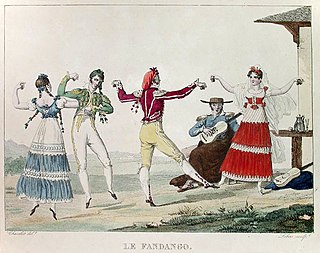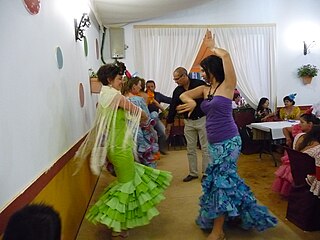Related Research Articles

Flamenco, in its strictest sense, is an art form based on the various folkloric music traditions of southern Spain, developed within the gitano subculture of the region of Andalusia, but also having a historical presence in Extremadura and Murcia. In a wider sense, it is a portmanteau term used to refer to a variety of both contemporary and traditional musical styles typical of southern Spain. Flamenco is closely associated to the gitanos of the Romani ethnicity who have contributed significantly to its origination and professionalization. However, its style is uniquely Andalusian and flamenco artists have historically included Spaniards of both gitano and non-gitano heritage.
The term rumba may refer to a variety of unrelated music styles. Originally, "rumba" was used as a synonym for "party" in northern Cuba, and by the late 19th century it was used to denote the complex of secular music styles known as Cuban rumba. Since the early 20th century the term has been used in different countries to refer to distinct styles of music and dance, most of which are only tangentially related to the original Cuban rumba, if at all. The vague etymological origin of the term rumba, as well as its interchangeable use with guaracha in settings such as bufo theatre, is largely responsible for such worldwide polysemy of the term. In addition, "rumba" was the primary marketing term for Cuban music in North America, as well as West and Central Africa, during much of the 20th century, before the rise of mambo, pachanga and salsa.
Bolero is a genre of song which originated in eastern Cuba in the late 19th century as part of the trova tradition. Unrelated to the older Spanish dance of the same name, bolero is characterized by sophisticated lyrics dealing with love. It has been called the "quintessential Latin American romantic song of the twentieth century".
The Music of Andalusia encompasses a range of traditional and modern musical genres which originate in the territory of Andalusia in southern Spain. The most famous are copla and flamenco, the latter being sometimes used as a portmanteau term for various regional musical traditions within Andalusia. Today, Andalusia has a rich and thriving musical scene, which draws from its own musical traditions as well as from external influences such as salsa, jazz or pop music.

Siguiriyas are a form of flamenco music in the cante jondo category. This deep, expressive style is among the most important in flamenco. Unlike other palos of flamenco, siguiriyas stands out for being purely Romani (Calé) in origin. Siguiriyas are normally played in the key of A Phrygian with each measure consisting of 12 counts with emphasis on the 1st, 3rd, 5th, 8th and 11th beats as shown here:
Guajira[ɡwaˈxi.ɾa] is a music genre derived from the punto cubano.

Fandango is a lively couples dance originating from Portugal and Spain, usually in triple metre, traditionally accompanied by guitars, castanets, or hand-clapping. Fandango can both be sung and danced. Sung fandango is usually bipartite: it has an instrumental introduction followed by "variaciones". Sung fandango usually follows the structure of "cante" that consist of four or five octosyllabic verses (coplas) or musical phrases (tercios). Occasionally, the first copla is repeated.

Sevillanas are a type of folk music and dance of Sevilla and its region. They were derived from the Seguidilla, an old Castilian folk music and dance genre. In the nineteenth century they were influenced by Flamenco. They have a relatively limited musical pattern but are rich in lyrics based on country life, virgins, country towns, neighborhoods, pilgrimage, and love themes.
Rumba flamenca, also known as flamenco rumba or simply rumba, is a palo (style) of flamenco music developed in Andalusia, Spain. It is known as one of the cantes de ida y vuelta, music which diverged in the new world, then returned to Spain in a new form. The genre originated in the 19th century in Andalusia, southern Spain, where Cuban music first reached the country.

The seguidilla is an old Castilian folksong and dance form in quick triple time for two people with many regional variations. The music is generally in a major key and often begins on an offbeat.

The jota is a genre of music and the associated dance known throughout Spain, most likely originating in Aragon. It varies by region, having a characteristic form in Aragon, Catalonia, Castile, Navarre, Cantabria, Asturias, Galicia, La Rioja, Murcia and Eastern Andalusia. Being a visual representation, the jota is danced and sung accompanied by castanets, and the interpreters tend to wear regional costumes. In Valencia, the jota was once danced during interment ceremonies.

A palo or cante is the name given in flamenco for the different traditional musical forms.
Tonás is a palo or type of flamenco songs. It belongs to the wider category of Cantes a palo seco, palos that are sung a cappella. Owing to this feature, they are considered by traditional flamencology to be the oldest surviving musical form of flamenco. This musical form originated in the Calé Romani subculture of Southern Spain. The first known flamenco singer, Tío Luis el de la Juliana, who lived in Jerez de la Frontera in the last third of the 18th century, was said to have excelled in this palo.
The cante flamenco, meaning "flamenco singing", is one of the three main components of flamenco, along with toque and baile (dance). Because the dancer is front and center in a flamenco performance, foreigners often assume the dance is the most important aspect of the art form — in fact, it is the cante which is the heart and soul of the genre. A cante singer is a cantaor or cantaora.
This is a glossary of terms that relate to flamenco arts.
Sebastián Cerezo was a Spanish dancer from La Mancha. In 1799, he was credited by Zamácola y Ocerín as one of the earliest and best dancers of the bolero, a Spanish dance developed between 1750 and 1772, which became very popular in Madrid, La Mancha, Andalusia and Murcia in the 1780s. According to Zamácola y Ocerín, Cerezo danced slowly and his particular way of dancing marked the definitive transition from seguidilla to bolero. This original slow way of dancing was promoted by Murcian dancer Requejo around 1800 in response to the faster style of bolero dancing that had become popular over the years.

Soleares is one of the most basic forms or palos of Flamenco music, probably originating among the Calé Romani people of Cádiz or Seville in Andalusia, the most southern region of Spain. It is usually accompanied by one guitar only, in phrygian mode "por arriba" ; "Bulerías por soleá" is usually played "por medio". Soleares is sometimes called "mother of palos" although it is not the oldest one and not even related to every other palo

Chants d'Espagne, Op. 232, is a suite of originally three, later five pieces for the piano by Isaac Albéniz. Prélude, Orientale and Sous le palmier were published in 1892, and Córdoba and Seguidillas were added in the 1898 edition. According to Günter Schulze, "Many...[of the works] have the flavor of the flamenco so beloved of Albéniz."[1]

Bolero is a Spanish dance in 3/4 time popular in the late 18th and early 19th centuries. It originated from the seguidilla sometime between 1750 and 1772, and it became very popular in Madrid, La Mancha, Andalusia and Murcia in the 1780s. Bolero was performed as a solo or partner dance with a moderately slow tempo, accompanied by guitar and castanets, and with lyrics in the form of the seguidilla.
The parranda is a traditional Spanish dance that originated from the Region of Murcia, the eastern areas of Almería, and the southeastern areas of Albacete in the 18th century. It is a dance similar to the seguidilla, and is usually characterized by its usage of extraordinary jumps and turns in the air.
References
- ↑ Manuel, Peter (2006). Tenzer, Michael (ed.). Analytical Studies in World Music . New York: Oxford University Press. p. 95.
- ↑ Schreiner, Claus, ed. (1990). Flamenco . WI, US: Amadeus Press. p. 69.
- ↑ Ruyter, Nancy Lee Chalfa (1 January 1993). "La Escuela Bolera". Dance Chronicle. 16 (2): 249–257. JSTOR 1567931.
- ↑ Blasis, Carlo (1830). The code of Terpsichore. The art of dancing, tr. by R. Barton. London, UK: Edward Bull. p. 34.